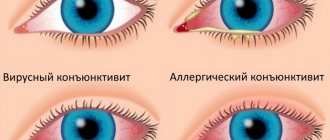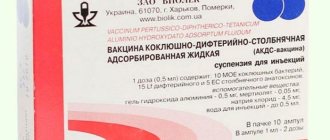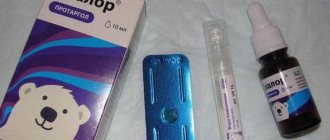Childhood vaccination is a hot topic, especially for parents. Polio vaccination raises many questions. This most dangerous disease of the nervous system often ends in peripheral paralysis. Therefore, polio vaccination is now included in the vaccination schedule.
Immunization is carried out with 2 types of polio drugs in several stages: first with an inactivated vaccine, then with a live one. And this last vaccination scares parents the most: what if the child gets infected with polio from the vaccinated person? Is it possible? Let's figure it out.
Are live vaccine drops dangerous?
So, to combat polio, 2 types of drugs have been created and are still used to this day.
This is an inactivated vaccine containing “killed” poliovirus, administered intramuscularly (also known as IPV). And an oral vaccine consisting of live attenuated viruses (known as OPV) that is dropped into the mouth. It includes strains grown in such a way that their neurovirulence (pathogenicity) is significantly reduced, that is, they are not capable of causing disease.
Once inside, OPV completely imitates the normal entry of pathogen cells into the body. It protects the gastrointestinal tract from infection, preventing viral replication, and therefore the release of pathogenic microorganisms in feces.
But OPV also has a disadvantage - viruses can regain their neurovirulent qualities (for example, if a child suffers from immunodeficiency or pathology of the digestive system), which can cause vaccine-associated paralytic poliomyelitis (VAPP) to develop. And this already threatens an unvaccinated person with infection upon contact with a sick person.
Today, many countries around the world have abandoned the live polio vaccine, where the disease has been completely eradicated. But the Russian Federation is not yet one of them; we still use OPV, although gradually reducing its use.
Live polio vaccine and an unvaccinated child: the possibility of infection from vaccinated children
Infectious diseases of a viral nature have become a real curse of humanity, along with diseases caused by bacteria. Every year, thousands of people around the world die or suffer irreparable damage to their health as a result of infection with various viruses.
Fortunately, man has learned to fight and even overcome some of them with the help of medicine. Some of the infectious diseases were defeated forever by the efforts of researchers, doctors and pharmacists. But even today they can remind themselves with outbreaks of spread. Such diseases include polio.
Is a child contagious after vaccination against polio and during what period does infection occur? Is it necessary to limit the contacts of vaccinated children with other (unvaccinated) children after vaccination? Which vaccine is better to vaccinate - live (in drops) or in injections? We'll figure out!
What kind of disease is this
Poliomyelitis is an acute infectious disease caused by the poliovirus hominis virus, which belongs to the group of enteroviruses, that is, intestinal viruses.
The disease is characterized by high contagiousness , that is, there is a high probability of infecting a random person with the disease.
The gray matter in the spinal cord is affected , leading to depression of the central nervous system and muscle paralysis.
At risk are children aged six months to seven years - they are the ones most likely to develop pathologies, but older people can also get sick.
Future US President Franklin Roosevelt suffered from polio at the age of thirty-nine!
The virus is transmitted through poor personal hygiene - through toys, unwashed hands, shared dishes and toilet items, or by airborne droplets.
A child of kindergarten age is prone to violating the rules of cleanliness, and in countries with a low level of sanitary culture, morbidity rates have always been higher.
Parents should be wary if they observe the following symptoms:
- temperature up to 39-40 °C;
- headaches and muscle pain;
- indigestion: nausea, vomiting, abnormal bowel movements, loss of appetite.
The incubation period lasts from three days to a month , usually about ten days - during this period the virus spreads throughout the body.
Forms of poliomyelitis depending on the nature of pathogenesis:
- Spinal – the upper parts of the spinal cord are affected, up to the lumbar.
- Bulbar - effects on the nuclei of the cranial nerves inside the spinal cord trunk.
- Pontine - the nucleus of the facial nerve is affected.
- Mixed forms, as derivatives of those listed.
To combat polio, different types of vaccines were developed and introduced by different scientists at different times.
Without going into medical details, they are divided into two main types:
- Culture-killed virus (IPV) – administered by injection, intramuscular or subcutaneous injection.
- Live but weakened culture (OPV) is administered orally and has the appearance of a well-known pinkish liquid with a specific taste.
Is it possible to get polio from a vaccinated child?
Each vaccine has its own pros and cons.
The one that a person receives through a syringe injection is safer, because it is dead.
A living virus, even artificially neutralized, can theoretically regain its pathogenic power. But this happens very rarely.
But the OPV vaccine produces more lasting immunity , even at the cellular level, since it is administered through the digestive tract, as a real virus would do.
And although the probability of illness from a living culture is very small, it still exists.
Therefore, in countries with Western European medical traditions, including the USA, living culture is used less and less, although it shows better results.
With an IPV vaccination, a child cannot infect anyone ; the process of producing antibodies occurs only inside the body.
“Live” polio, introduced into the body, remains viable for up to two months.
This means that there is a possibility that a child vaccinated against polio who has been in contact with unvaccinated children can infect another.
But not anyone, but only a subject who, firstly, is not vaccinated, and secondly, has problems with immunity.
A specialist will talk about the types of polio vaccine and the possibility of infection of vaccinated and unvaccinated children in this video:
Live polio vaccine and an unvaccinated child: is there a risk of infection?
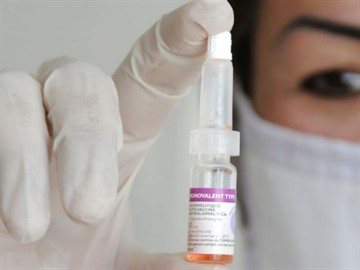
VAPP is diagnosed very rarely - one case per 500,000 - 2,000,000 doses. And this happens after the first injection. It has been established that with the second vaccination the frequency of this phenomenon is much less, and with the third it almost never occurs.
The chances of a healthy child getting infected from an injection are negligible. But is it possible to catch polio from someone who has already been vaccinated? Yes, theoretically.
Unvaccinated people suffering from immunodeficiency, pregnant women, and infants with pathologies of the immune system are susceptible to this threat. Therefore, caution should be exercised. In addition, if there are several children in a family, and one has already been vaccinated with OPV, then others who are not vaccinated may become infected with VAPP. It is transmitted through food or household contact.
After the OPV procedure, the virus exists in the child’s intestines for about two months. That is why parents are warned that if their child has just been vaccinated, he is prohibited from attending kindergartens during the above-mentioned period.
It is worth noting that the inactivated version of the vaccine cannot lead to infection. For this reason, some parents choose it.
Remember that viral shedding in children is extremely low, and during transmission, the volume of pathogenic particles decreases several times.
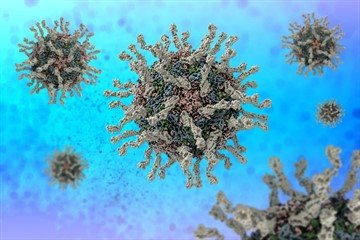
This means that if a child contracts vaccine-associated polio, this is not a reason to panic. As a rule, this infection passes in a mild form, without causing complications.
And yet, can a child infect others after being vaccinated against polio? Such cases are very rare and almost never observed in life. This is why it is important to understand the need for immunization. This is the only way to be sure that the virus will not affect anyone.
An unvaccinated child and polio vaccination - can he become infected from a vaccinated child with a live vaccine?
Childhood vaccination is a hot topic, especially for parents. Polio vaccination raises many questions. This most dangerous disease of the nervous system often ends in peripheral paralysis. Therefore, polio vaccination is now included in the vaccination schedule.
Immunization is carried out with 2 types of polio drugs in several stages: first with an inactivated vaccine, then with a live one. And this last vaccination scares parents the most: what if the child gets infected with polio from the vaccinated person? Is it possible? Let's figure it out.
Are live vaccine drops dangerous?
So, to combat polio, 2 types of drugs have been created and are still used to this day. This is an inactivated vaccine containing “killed” poliovirus, administered intramuscularly (also known as IPV).
And an oral vaccine consisting of live attenuated viruses (known as OPV) that is dropped into the mouth. It includes strains grown in such a way that their neurovirulence (pathogenicity) is significantly reduced, that is, they are not capable of causing disease.
Once inside, OPV completely imitates the normal entry of pathogen cells into the body. It protects the gastrointestinal tract from infection, preventing viral replication, and therefore the release of pathogenic microorganisms in feces.
But OPV also has a disadvantage - viruses can regain their neurovirulent qualities (for example, if a child suffers from immunodeficiency or pathology of the digestive system), which can cause vaccine-associated paralytic poliomyelitis (VAPP) to develop. And this already threatens an unvaccinated person with infection upon contact with a sick person.
Today, many countries around the world have abandoned the live polio vaccine, where the disease has been completely eradicated. But the Russian Federation is not yet one of them; we still use OPV, although gradually reducing its use.
Live polio vaccine and an unvaccinated child: is there a risk of infection?
VAPP is diagnosed very rarely - one case per 500,000 - 2,000,000 doses. And this happens after the first injection. It has been established that with the second vaccination the frequency of this phenomenon is much less, and with the third it almost never occurs.
The chances of a healthy child getting infected from an injection are negligible. But is it possible to catch polio from someone who has already been vaccinated? Yes, theoretically.
Unvaccinated people suffering from immunodeficiency, pregnant women, and infants with pathologies of the immune system are susceptible to this threat. Therefore, caution should be exercised. In addition, if there are several children in a family, and one has already been vaccinated with OPV, then others who are not vaccinated may become infected with VAPP. It is transmitted through food or household contact.
After the OPV procedure, the virus exists in the child’s intestines for about two months. That is why parents are warned that if their child has just been vaccinated, he is prohibited from attending kindergartens during the above-mentioned period.
It is worth noting that the inactivated version of the vaccine cannot lead to infection. For this reason, some parents choose it.
Remember that viral shedding in children is extremely low, and during transmission, the volume of pathogenic particles decreases several times.
This means that if a child contracts vaccine-associated polio, this is not a reason to panic. As a rule, this infection passes in a mild form, without causing complications.
And yet, can a child infect others after being vaccinated against polio? Such cases are very rare and almost never observed in life. This is why it is important to understand the need for immunization. This is the only way to be sure that the virus will not affect anyone.
The need for quarantine after vaccination
Quarantine is really necessary for a child who has been immunized against polio. Any doctor will confirm this. This procedure is necessary to avoid infecting other unvaccinated children with VAPP. Such a child is quarantined for 60 days.
Typically, a period of 60 days is enough for the virus to lose its infectious properties.
What should you do if an unvaccinated child came into contact with someone vaccinated against polio?
Indeed, what can happen to an unvaccinated baby, for example, in kindergarten when he comes into contact with a vaccinated OPV. Yes, a vaccinated child releases pathogenic strains into the environment for some time.
You need to understand that only virulent viruses pose a danger, and in order to become such, they must undergo a mutation in the intestines of the vaccinated person . This is possible if a person has a serious immunodeficiency, which in itself is a rare case.
Therefore, usually a vaccinated baby releases unchanged (non-dangerous) viruses in much smaller quantities (passive immunization) than they were injected with during immunization. That is, those around you who have received such a small dose simply maintain the tension of the immune system in the team.
This is the purpose of OPV vaccination. But even if we assume that an unvaccinated baby still managed to catch a virulent virus (that is, he also has severe immunodeficiency), the probability of contracting polio is only 5% (or less).
But, even if included in these statistics (which is absolutely incredible), the child is unlikely to get paralytic (which is what everyone is afraid of). The disease will go unnoticed or will be similar to ARVI or an intestinal infection.
And only 2% of children have a chance of getting vaccine-associated paralysis. But do not forget that such a baby has severe immunodeficiency. In addition, the contact must be long and close.
In a kindergarten setting, all of the above points are unlikely to coincide. Therefore, such cases were not recorded.
So, the maximum that can happen is that the child receives passive immunization. It should be remembered that this situation is only permissible with OPV vaccination, since no virus release occurs with IPV.
Signs of infection after contact with a child who has been vaccinated
As mentioned earlier, if an infection occurs, then most likely the baby will experience it asymptomatically, or the negative manifestations will resemble a cold or intestinal infection.
But even if the worst thing happened, and the child fell ill with vaccine-associated paralysis (VAPP), this is not a death sentence.
The treated pathology (according to statistical data) leaves paralysis in only 25% of those who have recovered from the disease, and in more than 30% of cases it is cured without consequences.
How does polio manifest? Symptoms of this disease can be diagnosed at different time periods and directly depend on the route of infection. Typically, a vaccine recipient may develop signs of polio within 4-30 days after immunization.
However, if a child is infected through contact with a person vaccinated with a live vaccine, symptoms usually appear after two or three months. Interestingly, immunocompromised individuals may develop vaccine-associated polio after as long as six months.
Based on severity, doctors distinguish three main forms of VAPP:
- mild, passing after a month (abortive form);
- paralytic, causing the syndromes of the same name and increasing the fragility of bone tissue;
- and severe, capable of causing disability (muscle atrophy) or even death.
Symptoms of VAPP include:
- headache;
- increase in body temperature;
- muscle twitching;
- cough;
- pain in the back and limbs;
- rhinitis;
- insomnia (or vice versa, drowsiness);
- and dyspeptic disorders.
It should be noted that symptoms rarely last more than a month. But paralytic forms of VAPP are much more difficult for children to tolerate. Here the muscles of almost the entire body suffer greatly.
Vaccinated children are not dangerous to others. The exception is OPV vaccination. After this procedure, the patient releases viral strains into the environment for another 60 days. During this period, if there is close contact, an unvaccinated baby may become infected.
But if by this time he has already undergone 2-fold IPV vaccination, he will never get VAPP, which means he can safely contact people vaccinated with OPV. It should be remembered that a child can only get vaccine-associated polio if he has an immunodeficiency.
However, if there is even potential contact with a vaccinated OPV, the unvaccinated baby should be vaccinated.
If you refuse the procedure, be sure to separate the children for 2 months from the date of oral immunization.
on this topic
Is a child contagious after vaccination? An allergist-immunologist answers:
The eradication of polio is the most important global health project, based on the history of the use of 2 highly effective vaccines, which have their pros and cons. First, IPV showed good preventive results, but also multiple adverse reactions. This led to the widespread use of OPV for many years.
But it also had problems - vaccine-related polioviruses and VAPP. Therefore, in recent years there has been a tendency to replace oral polyoprepants with inactivated ones. In some countries, live vaccines are not used at all. Perhaps it will be the same in our country.
However, for now, doctors are guided by the adopted law, according to which the most effective protection against various polioviruses can be achieved by first using IPV and ending with oral vaccines.
Source: https://vactsina.com/privivki-i-ukolyi/zarazitsya-ot-privitogo-poliomielitom.html
What should you do if an unvaccinated child came into contact with someone vaccinated against polio?
Indeed, what can happen to an unvaccinated baby, for example, in kindergarten when he comes into contact with a vaccinated OPV.
Yes, a vaccinated child releases pathogenic strains into the environment for some time. You need to understand that only virulent viruses pose a danger, and in order to become such, they must undergo a mutation in the intestines of the vaccinated person . This is possible if a person has a serious immunodeficiency, which in itself is a rare case.
Therefore, usually a vaccinated baby releases unchanged (non-dangerous) viruses in much smaller quantities (passive immunization) than they were injected with during immunization. That is, those around you who have received such a small dose simply maintain the tension of the immune system in the team.
This is the purpose of OPV vaccination. But even if we assume that an unvaccinated baby still managed to catch a virulent virus (that is, he also has severe immunodeficiency), the probability of contracting polio is only 5% (or less).
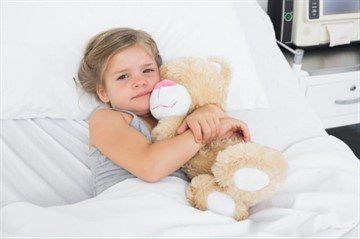
But, even if included in these statistics (which is absolutely incredible), the child is unlikely to get paralytic (which is what everyone is afraid of). The disease will go unnoticed or will be similar to ARVI or an intestinal infection.
And only 2% of children have a chance of getting vaccine-associated paralysis. But do not forget that such a baby has severe immunodeficiency. In addition, the contact must be long and close.
In a kindergarten setting, all of the above points are unlikely to coincide. Therefore, such cases were not recorded.
So, the maximum that can happen is that the child receives passive immunization. It should be remembered that this situation is only permissible with OPV vaccination, since no virus release occurs with IPV.
Signs of infection after contact with a child who has been vaccinated
As mentioned earlier, if an infection occurs, then most likely the baby will experience it asymptomatically, or the negative manifestations will resemble a cold or intestinal infection.
But even if the worst thing happened, and the child fell ill with vaccine-associated paralysis (VAPP), this is not a death sentence.
The treated pathology (according to statistical data) leaves paralysis in only 25% of those who have recovered from the disease, and in more than 30% of cases it is cured without consequences.
How does polio manifest? Symptoms of this disease can be diagnosed at different time periods and directly depend on the route of infection. Typically, a vaccine recipient may develop signs of polio within 4-30 days after immunization.
However, if a child is infected through contact with a person vaccinated with a live vaccine, symptoms usually appear after two or three months. Interestingly, immunocompromised individuals may develop vaccine-associated polio after as long as six months.
Based on severity, doctors distinguish three main forms of VAPP:
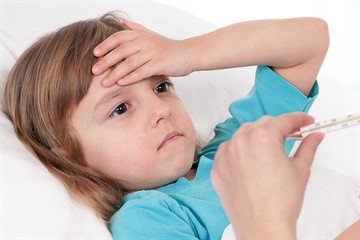
- mild, passing after a month (abortive form);
- paralytic, causing the syndromes of the same name and increasing the fragility of bone tissue;
- and severe, capable of causing disability (muscle atrophy) or even death.
Symptoms of VAPP include:
- headache;
- increase in body temperature;
- muscle twitching;
- cough;
- pain in the back and limbs;
- rhinitis;
- insomnia (or vice versa, drowsiness);
- and dyspeptic disorders.
It should be noted that symptoms rarely last more than a month. But paralytic forms of VAPP are much more difficult for children to tolerate. Here the muscles of almost the entire body suffer greatly.
Vaccinated children are not dangerous to others. The exception is OPV vaccination. After this procedure, the patient releases viral strains into the environment for another 60 days. During this period, if there is close contact, an unvaccinated baby may become infected.
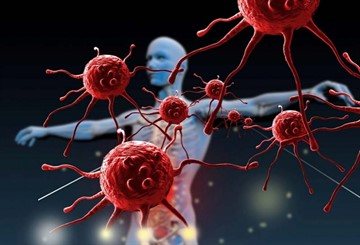
But if by this time he has already undergone 2-fold IPV vaccination, he will never get VAPP, which means he can safely contact people vaccinated with OPV. It should be remembered that a child can only get vaccine-associated polio if he has an immunodeficiency.
However, if there is even potential contact with a vaccinated OPV, the unvaccinated baby should be vaccinated.
If you refuse the procedure, be sure to separate the children for 2 months from the date of oral immunization.
